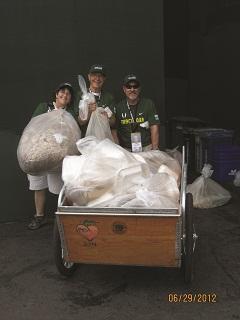

A source of community pride for fans and athletes alike:
The Ohio State University football stadium achieved a 98% diversion rate of all waste from the landfill. The U.S. Olympic Trials-Track and Field used 100% renewable power for the meet. A local triathlon donated all leftover food to the local food bank.
For nearly a decade, the sports community has been innovating and advancing more sustainable events. Starting in 2003, the Natural Resources Defense Council (NRDC) helped renovate the first green energy efficient NFL stadium, Lincoln Field, home to the Philadelphia Eagles. Three years later, the International Olympic Committee (IOC) issued the Guide on Sport, the Environment and Sustainable Development to support more responsible sporting events. The momentum continued in 2010 with the creation of the Green Sports Alliance for North American professional sport teams. And the 2010 Vancouver Winter and 2012 London Summer Olympics were the most sustainable large-scale sporting events ever.
Nevertheless, concerns over our planet’s ability to sustain life continue to this day. Each day, humans add over 90 million tons of global warming air pollution into the atmosphere. In the U.S., we throw away over 25% of the food we grow annually. Harvard biologist E.O. Wilson estimates that over 70 species a day go extinct due to habitat destruction. It is clear that human consumption and waste have a negative impact on the earth.
Some may ask, “Why should the sports community worry about sustainability?” A more appropriate question would be, “Why not?” As IOC President Jacques Rogge states; “A sport, like recreation and physical education activities, is an integral part of society; it cannot ignore environmental and sustainable development issues.”
Some form of sport is a part of almost every culture on the planet, bringing together people from all walks of life. In the U.S., sport drives over $400 billion in annual economic activity. A 2011 study by the Marist Institute for Public Opinion found that 13% of US citizens follow science, while over 61% identify themselves as sports fans. With so much attention, sporting events provide a critical opportunity to start a cultural shift toward a sustainable future.
But what exactly is a sustainable sporting event?
While there are many different approaches, models, and certification systems, the most basic elements of a sustainable event include reducing energy use and carbon emissions, conserving water, maximizing recycling opportunities and minimizing waste headed to a landfill, supporting local businesses, providing access to all and building a positive legacy within the community.

To begin with, a sporting event doesn’t need a major corporate sustainability sponsor to make a difference. While Eugene’s green accomplishments with the 2008 and 2012 U.S. Olympic Trials-Track and Field and the Eugene Marathon have been highly lauded, our community’s capacity to do so was developed by staging many smaller sustainable events over time.
For example, the Emerald City Roller Girls, a small non-profit, roller derby association, maintains a zero-waste policy at all their roller derby events. And the Fat55 Mountain Bike race in nearby Oakridge emphasizes the culture of mountain biking above and beyond just a fast ride, making environmental respect an integral part of the event from trail maintenance to serving only organic foods.
Green Basics
Start where you are. A local high school football game or a Little League tournament are great ways to begin discovering local green resources and cultivating new sustainable options. Large or small, there are some very simple things sports planners can do to produce more sustainable events. The first step is to gain buy-in from your organization, board, and/or stakeholders so that your efforts are supported and integrated within the overall event management system.
Rethink Waste: Identify ways to eliminate or reduce paper, plastic and packaging waste. One of the easiest actions with the biggest impact is to default to double-sided printing at work stations and use at least 30% recycled paper in printers and copiers. You can go even further by opting to replace flyers, programs, and paper tickets with Web pages, social media, electronic ticketing and, for the adventurous, mobile applications. Select biodegradable or recycled materials for items like T-shirts, lanyards and food service-ware. Provide water stations where fans can fill reusable water bottles and serve condiments in bulk to reduce individual packaging waste. And, of course, place clearly marked recycling and compost bins in visible and convenient locations throughout the venue.

Green Accommodations: When booking the sports facilities and housing for athletes and staff, inquire about green management policies and choose the venues that offer the most sustainable options. One of the nationwide systems for hotels is the Green Seal Standard for Lodging. When contracting with a venue operator, look for those that contract with cleaning companies, vendors and promotional partners that implement green practices and use environmentally sound products. Whether you own and operate a facility, or are a perennial renter, by implementing more sustainable operations, you can save financial resources in the process. If you are just starting your journey, look at the Green Sports Alliance’s Operations Roadmap for assistance. For the more initiated, the U.S. Green Building Council’s LEED for Existing Building Operations and Maintenance system can provide in-depth guidance.
Advanced Practices
When people think of “going green,” the environmental piece usually comes to mind first, but sustainability also includes important economic and social components. By utilizing local businesses for service and supplies, sports planners provide a bump to the local economy. At the same time, they reduce shipping, packaging and other extraneous waste from bringing in out-of-area supplies or crews.

Ensure that the selected venue is ADA-compliant and have solutions ready for those who may need additional assistance during the event. Designate a group of tickets for schools or a non-profit organization, or create opportunities to involve community members in the event that may often miss out due to economic, physical or developmental disabilities. Donate leftover food and supplies to food banks and shelters.
Third-party Certification
OK, let’s say you’ve made the commitment to sustainably operate your event. You’ve put in the hours and sweat to create meaningful change. You’re doing the right thing and you’ve truly become more sustainable. So, what exactly is the point of pursuing certification?
First things first: what, exactly, is certification?
In short, event certification from the Council for Responsible Sport formally recognizes a significant achievement: the successful completion of a socially and environmentally responsible sporting event. Currently, the Council is the only U.S.-based third-party certifier for sustainable sporting events, and their standards dovetail with international standards such as ISO-20121.
The Council’s sustainability standards cover nine different areas, ranging from waste management and climate impact to community involvement, health promotion and more. One credit is awarded for each standard met; innovation credits are available for practices not defined in the standards. Based on credits earned, events are eligible for one of four levels of certification which is valid for two years.
The answer to the question of “Why Certify?” is a little more complex. With 44 events having achieved certification from the Council to date, ranging from a charity dodge ball tournament to the 2012 U.S. Olympic Trials (Track and Field as well as the Marathon Trials), answers to the 'why certify' question run the gamut:
• Certification offers a tangible way to differentiate your event from others
• It provides a platform for demonstrating commitment to the environment and social leadership
• It tells local administrators and politicians that your event is committed to supporting the community
• It appeals to potential sponsors
• It comes with independent, third-party verification of your good, hard work.
• It’s credible public relations, not just green marketing or ’green washing’.

Basic certification starts with earning 26 of 66 possible credits; the more credits earned, the higher the level of certification earned. There are only three mandatory credits and the rest are up to you to fit in with what makes sense in your operations.
Documenting your efforts is fairly simple, starting with stating your plan, then delivering the data to confirm your actions post-event. Examples include: What were the actual weights of the event’s waste stream (recycling, compost and trash)? How much of your energy use was supplied by renewable energy sources? What percentage of food and beverages supplied by the event were certified organic or locally grown?
Disclaimer: Nobody said it would be easy to earn certification from the Council for Responsible Sport, nor should it be. It is a rigorous process, but don’t let that fact discourage you from trying.
Next Steps
Your success in becoming more sustainable rests in a long-term commitment to a vision, building partnerships along the way (we all need help), and making sure to communicate your efforts so that fans, participants, sponsors and the media provide the support needed to make a difference.
Sport event sustainability is gaining momentum with more visitor bureaus, sports commissions, non-profits, consultants, municipalities, and sponsors creating valuable resources and sharing new tools with each other.
Increasingly, sport destination partners can help you access resources. For example Eugene, Cascades & Coast Sports, the sports commission for Eugene and the surrounding area, offers a section on their website (www.EugeneCascadesCoastSports.org) with tips and resource links to holding a more sustainable sport event in our destination.



